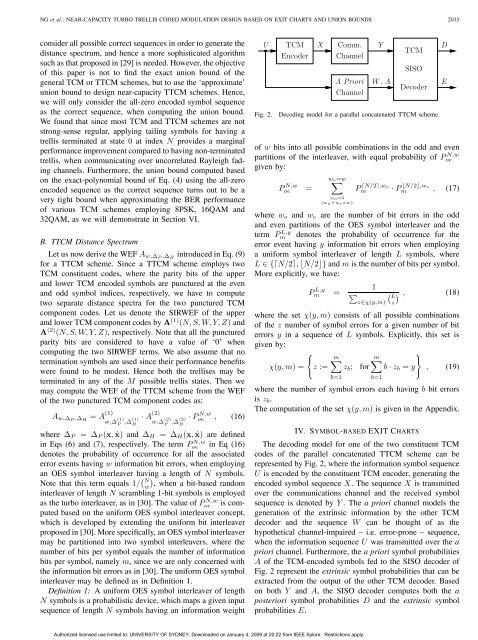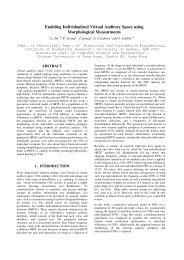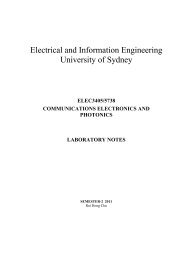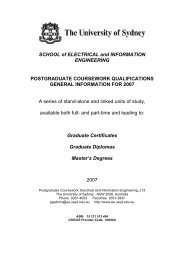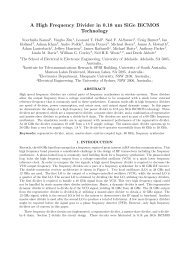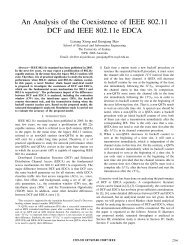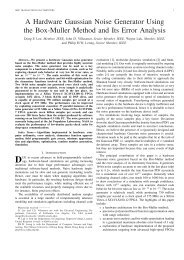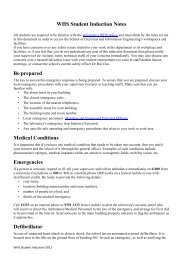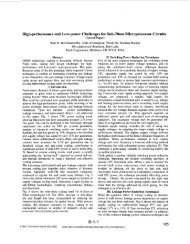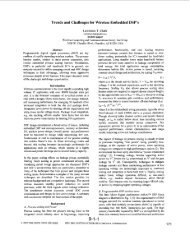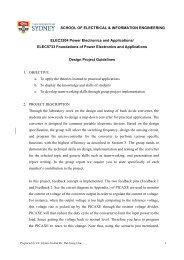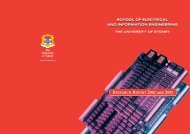Near-capacity turbo trellis coded modulation design based on union ...
Near-capacity turbo trellis coded modulation design based on union ...
Near-capacity turbo trellis coded modulation design based on union ...
You also want an ePaper? Increase the reach of your titles
YUMPU automatically turns print PDFs into web optimized ePapers that Google loves.
NG et al.: NEAR-CAPACITY TURBO TRELLIS CODED MODULATION DESIGN BASED ON EXIT CHARTS AND UNION BOUNDS 2033<br />
c<strong>on</strong>sider all possible correct sequences in order to generate the<br />
distance spectrum, and hence a more sophisticated algorithm<br />
such as that proposed in [29] is needed. However, the objective<br />
of this paper is not to find the exact uni<strong>on</strong> bound of the<br />
general TCM or TTCM schemes, but to use the ‘approximate’<br />
uni<strong>on</strong> bound to <str<strong>on</strong>g>design</str<strong>on</strong>g> near-<str<strong>on</strong>g>capacity</str<strong>on</strong>g> TTCM schemes. Hence,<br />
we will <strong>on</strong>ly c<strong>on</strong>sider the all-zero en<str<strong>on</strong>g>coded</str<strong>on</strong>g> symbol sequence<br />
as the correct sequence, when computing the uni<strong>on</strong> bound.<br />
We found that since most TCM and TTCM schemes are not<br />
str<strong>on</strong>g-sense regular, applying tailing symbols for having a<br />
<str<strong>on</strong>g>trellis</str<strong>on</strong>g> terminated at state 0 at index N provides a marginal<br />
performance improvement compared to having n<strong>on</strong>-terminated<br />
<str<strong>on</strong>g>trellis</str<strong>on</strong>g>, when communicating over uncorrelated Rayleigh fading<br />
channels. Furthermore, the uni<strong>on</strong> bound computed <str<strong>on</strong>g>based</str<strong>on</strong>g><br />
<strong>on</strong> the exact-polynomial bound of Eq. (4) using the all-zero<br />
en<str<strong>on</strong>g>coded</str<strong>on</strong>g> sequence as the correct sequence turns out to be a<br />
very tight bound when approximating the BER performance<br />
of various TCM schemes employing 8PSK, 16QAM and<br />
32QAM, as we will dem<strong>on</strong>strate in Secti<strong>on</strong> VI.<br />
B. TTCM Distance Spectrum<br />
Let us now derive the WEF A w,ΔP ,Δ H<br />
introduced in Eq. (9)<br />
for a TTCM scheme. Since a TTCM scheme employs two<br />
TCM c<strong>on</strong>stituent codes, where the parity bits of the upper<br />
and lower TCM en<str<strong>on</strong>g>coded</str<strong>on</strong>g> symbols are punctured at the even<br />
and odd symbol indices, respectively, we have to compute<br />
two separate distance spectra for the two punctured TCM<br />
comp<strong>on</strong>ent codes. Let us denote the SIRWEF of the upper<br />
and lower TCM comp<strong>on</strong>ent codes by A (1) (N,S,W,Y,Z) and<br />
A (2) (N,S,W,Y,Z), respectively. Note that all the punctured<br />
parity bits are c<strong>on</strong>sidered to have a value of ‘0’ when<br />
computing the two SIRWEF terms. We also assume that no<br />
terminati<strong>on</strong> symbols are used since their performance benefits<br />
were found to be modest. Hence both the <str<strong>on</strong>g>trellis</str<strong>on</strong>g>es may be<br />
terminated in any of the M possible <str<strong>on</strong>g>trellis</str<strong>on</strong>g> states. Then we<br />
may compute the WEF of the TTCM scheme from the WEF<br />
of the two punctured TCM comp<strong>on</strong>ent codes as:<br />
A w,ΔP ,Δ H<br />
= A (1) · A (2) · Poe N,w , (16)<br />
w,Δ (1)<br />
P<br />
,Δ(1) H<br />
w,Δ (2)<br />
P<br />
,Δ(2) H<br />
where Δ P = Δ P (x, ˆx) and Δ H = Δ H (x, ˆx) are defined<br />
in Eqs (6) and (7), respectively. The term Poe N,w in Eq (16)<br />
denotes the probability of occurrence for all the associated<br />
error events having w informati<strong>on</strong> bit errors, when employing<br />
an OES symbol interleaver having a length of N symbols.<br />
Note that this term equals 1/ ( N<br />
w)<br />
, when a bit-<str<strong>on</strong>g>based</str<strong>on</strong>g> random<br />
interleaver of length N scrambling 1-bit symbols is employed<br />
as the <str<strong>on</strong>g>turbo</str<strong>on</strong>g> interleaver, as in [30]. The value of Poe<br />
N,w is computed<br />
<str<strong>on</strong>g>based</str<strong>on</strong>g> <strong>on</strong> the uniform OES symbol interleaver c<strong>on</strong>cept,<br />
which is developed by extending the uniform bit interleaver<br />
proposed in [30]. More specifically, an OES symbol interleaver<br />
may be partiti<strong>on</strong>ed into two symbol interleavers, where the<br />
number of bits per symbol equals the number of informati<strong>on</strong><br />
bits per symbol, namely m, since we are <strong>on</strong>ly c<strong>on</strong>cerned with<br />
the informati<strong>on</strong> bit errors as in [30]. The uniform OES symbol<br />
interleaver may be defined as in Definiti<strong>on</strong> 1.<br />
Definiti<strong>on</strong> 1: A uniform OES symbol interleaver of length<br />
N symbols is a probabilistic device, which maps a given input<br />
sequence of length N symbols having an informati<strong>on</strong> weight<br />
U<br />
Fig. 2.<br />
TCM<br />
Encoder<br />
X<br />
Comm.<br />
Channel<br />
APriori<br />
Channel<br />
Y<br />
W , A<br />
TCM<br />
SISO<br />
Decoder<br />
Decoding model for a parallel c<strong>on</strong>catenated TTCM scheme.<br />
of w bits into all possible combinati<strong>on</strong>s in the odd and even<br />
partiti<strong>on</strong>s of the interleaver, with equal probability of Poe<br />
N,w<br />
given by:<br />
P N,w<br />
oe =<br />
w∑<br />
o=w<br />
wo=0<br />
(wo+we=w)<br />
P ⌈N/2⌉,wo<br />
m<br />
D<br />
E<br />
· P ⌊N/2⌋,we<br />
m , (17)<br />
where w o and w e are the number of bit errors in the odd<br />
and even partiti<strong>on</strong>s of the OES symbol interleaver and the<br />
term Pm<br />
L,y denotes the probability of occurrence for the<br />
error event having y informati<strong>on</strong> bit errors when employing<br />
a uniform symbol interleaver of length L symbols, where<br />
L ∈{⌈N/2⌉, ⌊N/2⌋} and m is the number of bits per symbol.<br />
More explicitly, we have:<br />
P L,y<br />
m =<br />
1<br />
∑ ( L<br />
) , (18)<br />
z∈χ(y,m) z<br />
where the set χ(y, m) c<strong>on</strong>sists of all possible combinati<strong>on</strong>s<br />
of the z number of symbol errors for a given number of bit<br />
errors y in a sequence of L symbols. Explicitly, this set is<br />
given by:<br />
{<br />
}<br />
m∑<br />
m∑<br />
χ(y, m) = z := z b ; for b · z b = y , (19)<br />
b=1<br />
b=1<br />
where the number of symbol errors each having b bit errors<br />
is z b .<br />
The computati<strong>on</strong> of the set χ(y, m) is given in the Appendix.<br />
IV. SYMBOL-BASED EXIT CHARTS<br />
The decoding model for <strong>on</strong>e of the two c<strong>on</strong>stituent TCM<br />
codes of the parallel c<strong>on</strong>catenated TTCM scheme can be<br />
represented by Fig. 2, where the informati<strong>on</strong> symbol sequence<br />
U is en<str<strong>on</strong>g>coded</str<strong>on</strong>g> by the c<strong>on</strong>stituent TCM encoder, generating the<br />
en<str<strong>on</strong>g>coded</str<strong>on</strong>g> symbol sequence X. The sequence X is transmitted<br />
over the communicati<strong>on</strong>s channel and the received symbol<br />
sequence is denoted by Y .Theapriorichannel models the<br />
generati<strong>on</strong> of the extrinsic informati<strong>on</strong> by the other TCM<br />
decoder and the sequence W can be thought of as the<br />
hypothetical channel-impaired – i.e. error-pr<strong>on</strong>e – sequence,<br />
when the informati<strong>on</strong> sequence U was transmitted over the a<br />
priori channel. Furthermore, the apriorisymbol probabilities<br />
A of the TCM-en<str<strong>on</strong>g>coded</str<strong>on</strong>g> symbols fed to the SISO decoder of<br />
Fig. 2 represent the extrinsic symbol probabilities that can be<br />
extracted from the output of the other TCM decoder. Based<br />
<strong>on</strong> both Y and A, the SISO decoder computes both the a<br />
posteriori symbol probabilities D and the extrinsic symbol<br />
probabilities E.<br />
Authorized licensed use limited to: UNIVERSITY OF SYDNEY. Downloaded <strong>on</strong> January 4, 2009 at 20:22 from IEEE Xplore. Restricti<strong>on</strong>s apply.


